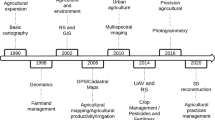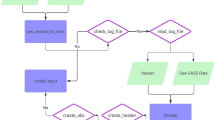Abstract
There is increasing demand for multi-level declassification of geographic vector field data in the big data era. Different from traditional encryption, declassification does not aim at making the original data unavailable through perturbation and transformation. During declassification process, the general geospatial features are usually retained but the detailed information is hidden from the perspective of data security. Furthermore, when faced with different levels of confidentiality, different levels of declassification are needed. In this paper, A declassification and reversion method with multi-level schemes is realized under the geometric algebra (GA) framework. In our method, the geographic vector field data is uniformly expressed as a GA object. Then, the declassification methods are proposed for vector field data with the rotor operator and perturbation operator. The declassification methods can progressively hide the detailed information of the vector field by vector rotating and vector perturbating. To make our method more unified and adaptive, a GA declassification operator is also constructed to realize the declassification computing of geographic vector field data. Our method is evaluated quantitatively by comparing the numerical and structure characterization of the declassification results with the original data. Divergence and curl calculating results are also compared to evaluate the reanalysis ability of the declassification results. Experiments have shown that our method can perform effective multi-level controls and has good randomness and a high degree of freedom in numerical and structure characteristics of geophysical vector field data. The method can well capture the application needs of geographic vector field data in data disclosure, secure transmission, encapsulation storage, and other aspects.







Similar content being viewed by others
Data Availability
The 2D and 3D vector field data that support the findings of this study are available in figshare with the identifier https://doi.org/10.6084/m9.figshare.17762696.v3
References
Bang, N.V., Moon, K.S., Lim, S., et al.: Selective encryption scheme for vector map data using chaotic map. J. Korea Multimed. Soc. 18(7), 818–826 (2015)
Beconytë, G., Govorov, M., Ningal, T.F., et al.: Geographic information e-training initiatives for national spatial data infrastructures. Technol. Econom. Dev. Econ. 14(1), 11–28 (2008)
Boxall, J.: The nature of geospatial information and security. Gov. Inform. Quart. 22(4), 644–662 (2006)
Chung, M.S., Choi, Y.B.: A study on policy for national geographic information system. J. Korea Spat. Inform. Syst. Soc. 8(3), 51–64 (2006)
Doran, C., Lasenby, A.: Geometirc Algebra for Computer Science. Morgan Kaufmann, San Mateo (2008)
Dorst, L., Fontijne, D., Mann, S.: Geometric algebra for computer science - an object-oriented approach to geometry. Morgan Kaufmann, San Francisco (2009)
Ebling, J., Scheuermann, G.: Clifford convolution and pattern matching on vector fields. IEEE Visualization ’03, IEEE Computer Society, Los Alamitos, 193–200 (2003)
Fitch, C.A., Ruggles, S.: Building the national historical geographic information system. Hist. Methods J. Quantit. Interdiscip. Hist. 36(1), 41–51 (2003)
Hestenes, D.: New Foundations for Classical Mechanics. Kluwer, New York (2002)
Hitzer, E., Nitta, T., Kuroe, Y.: Applications of Clifford’s geometric algebra. Adv. Appl. Cliff. Algebras 23(2), 377–404 (2013)
Hsiao, H., Lee, J.: Color image encryption using chaotic nonlinear adaptive filter. Signal Process. 117, 281–309 (2015)
Li, A., Li, S., Lv, G.: Disguise and reduction methods of GIS vector data based on difference expansion principle. Proc. Eng. 29, 1344–1350 (2012)
Liu, S., Guo, C., Sheridan, J.T.: A review of optical image encryption techniques. Opt Laser Technol 57, 327–342 (2014)
Martin, CE., Dunn, JH.: Multi-level security, geographically targeted information dissemination using internet protocol version 6 (IPv6), MILCOM 2006–2006 IEEE Military Communications conference, 1–6 (2006)
Ming, J., Jiang, N., Li, C.: Linear correction method of image background unevenness. Mod. Electron. Tech. 10, 81–82 (2010). (In Chinese)
Minguillon, J., Pujol, J.: JPEG standard uniform quantization error modeling with applications to sequential and progressive operation modes. Electron. Imaging 10(2), 475–485 (2001)
Neyman, S.N., Sitohang, B., Sutisna, S.: Reversible fragile watermarking based on difference expansion using Manhattan distances for 2D vector map. Proc. Technol. 11, 614–620 (2013)
Ngoc, G.P., Lee, S.H., Kwon, K.R.: Selective encryption algorithm for GIS vector map using geometric objects. Int. J. Secur. Appl. 9(2), 61–71 (2015)
Park, J.H., Giao, P.N., Seung, T.Y., et al.: Selective-encrypted GIS vector map with low complexity. Int. Conf. Inform. Network. 2015, 98–103 (2015)
Pham, N.G., Lee, S.H., Kwon, K.R.: Perceptual encryption based on features of interpolating curve for vector map. IEICE Trans. Fund. Electron. Commun. Comput. Sci. E100A(5), 1156–1164 (2017)
Santanu, R.A., et al.: A study about color normalization methods for histopathology images. Micron 114, 42–61 (2018)
Schoepe, D., Sabelfeld, A.: Understanding and enforcing opacity. In: 2015 IEEE 28th Computer Security Foundations Symposium. IEEE, 539-553 (2015)
Shao, F., Jiang, G., Yu, M.: Color correction and geometric calibration for multi-view images with feature correspondence. Optoelectron. Lett. 5(003), 232–235 (2009)
Van, B.N., Lee, S.H., Kwon, K.R.: Selective encryption algorithm using hybrid transform for GIS vector map. J. Inform. Process. Syst. 13(1), 68–82 (2017)
Wang, X., Shao, C., Xu, X., et al.: Reversible data-hiding scheme for 2-D vector maps based on difference expansion. IEEE Trans. Inform. Foren. Secur. 2(3), 311–320 (2007)
Wu, F., Cui, W., Chen, H.: A compound chaos-based encryption algorithm for vector geographic data under network circumstance: 2008 Congress on Image and Signal Processing, 2008. 27–30 (2008)
Xie, N.: Research on the Security of geospatail data based ont he bilinear interpolation model. Geomat. Spat. Inform. Technol 39(03), 143–145 (2016). (In Chinese)
Yu, Z., Luo, W., Yi, L., et al.: Clifford algebra-based structure filtering analysis for geophysical vector fields. Nonlin. Processes Geophys. 20(4), 563–570 (2013)
Yuan, L., Lv, G., Luo, et al.: Geometric Algebra Method for Multidimensionally-Unified GIS Computation. Chinese Sci. Bull. 57(07), 802–811 (2012)
Yuan, L., Yu, Z., Luo, W., et al.: Pattern forced geophysical vector field segmentation based on Clifford FFT. Comput. Geosci. 60, 63–69 (2013)
Yuan, L., Yu, Z., Luo, W., et al.: Geometric algebra for multidimension-unified geographical information system. Adv. Appl. Clifford Algebras 23(2), 497–518 (2013)
Acknowledgements
This work was supported by the National Natural Science Foundation of China (Grant Nos. 41631177, 41976186, 42001320).
Author information
Authors and Affiliations
Corresponding author
Ethics declarations
Conflicts of Interest
The authors declare no conflict of interest.
Additional information
Publisher's Note
Springer Nature remains neutral with regard to jurisdictional claims in published maps and institutional affiliations.
This article is part of the ENGAGE 2020 Topical Collection on Geometric Algebra for Computing, Graphics and Engineering edited by Werner Benger, Dietmar Hildenbrand, Eckhard Hitzer, and George Papagiannakis.
Rights and permissions
Springer Nature or its licensor holds exclusive rights to this article under a publishing agreement with the author(s) or other rightsholder(s); author self-archiving of the accepted manuscript version of this article is solely governed by the terms of such publishing agreement and applicable law.
About this article
Cite this article
Luo, W., Wang, Y., Zhang, X. et al. Multilevel Declassification Method for Geographic Vector Field Data: A Geometric Algebra Approach. Adv. Appl. Clifford Algebras 32, 52 (2022). https://doi.org/10.1007/s00006-022-01229-9
Received:
Accepted:
Published:
DOI: https://doi.org/10.1007/s00006-022-01229-9




